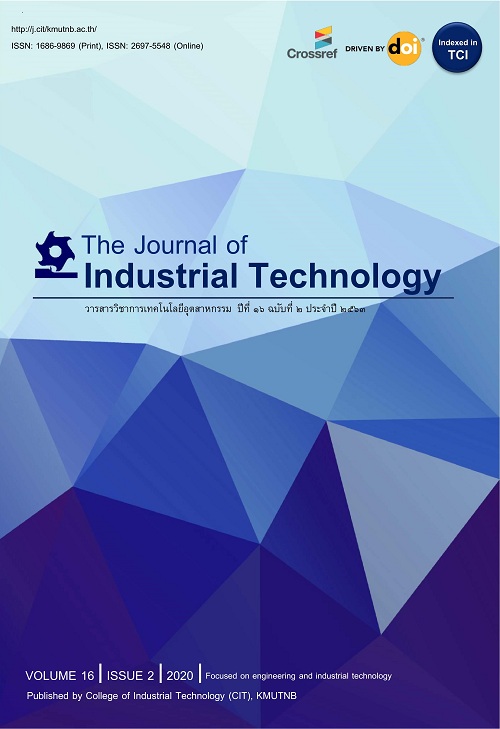อิทธิพลของเถ้าถ่านหินขนาดเดิมและบดละเอียด ต่อกำลังอัด ความพรุน และการต้านทานคลอไรด์ของคอนกรีต
Influence of Original and Ground Fly Ash on Compressive Strength, Porosity and Chloride Resistance of Concrete
Abstract
งานวิจัยนี้เสนอการศึกษากำลังอัด ความพรุน การต้านทานคลอไรด์ และการกัดกร่อนของคอนกรีตผสมเถ้าถ่านหินที่มีความละเอียดแตกต่างกัน ปูนซีเมนต์ปอร์ตแลนด์ชนิดที่ 1 (CT) แทนที่ด้วยเถ้าถ่านหินขนาดเดิม (FAO) เถ้าถ่านหินบดละเอียดปานกลาง (GFAM) และเถ้าถ่านหินบดละเอียดที่สุด (GFAF) ในปริมาณร้อยละ 20, 30 และ 40 โดยน้ำหนักวัสดุประสาน งานวิจัยนี้ใช้อัตราส่วนน้ำต่อวัสดุประสานคงที่เท่ากับ 0.45 ใช้สารลดน้ำพิเศษสำหรับเพิ่มความสามารถทำงานได้ของคอนกรีต ผลการทดสอบพบว่า การใช้เถ้าถ่านหินขนาดละเอียดที่สุด (GFAF) ส่งผลให้ความพรุนของคอนกรีตลดลงและค่ากำลังอัดสูงขึ้น การต้านทานคลอไรด์และการกัดกร่อนของคอนกรีตผสมเถ้าถ่านหินขนาดเดิม (FAO) เพิ่มขึ้นเมื่อเทียบกับคอนกรีตที่ใช้ปูนซีเมนต์ปอร์ตแลนด์ชนิดที่ 1 (CT) เพียงอย่างเดียว
This research presents a study of the compressive strength, porosity, resistance to chloride and corrosion of concrete containing fly ashes with different fineness. Ordinary Portland Cement Type I (CT) was partially replaced with original fly ash (FAO), ground medium fly ash (GFAM) and ground fine fly ash (GFAF) at the dosage levels of 20%, 30% and 40% by weight of cementitious materials. Water to binder ratio with a constant of 0.45 was used in this research. Superplasticizer (SP) was used to improve the workability of concrete. Test results found that the use of fine fly ash (GFAF) produced mixes of concrete with low porosity and good compressive strength. The resistance to chloride and corrosion of original fly ash (FAO) concrete increase in comparison with that of Ordinary Portland Cement Type I (CT).
Keywords
กำลังอัด; การกัดกร่อน; คลอไรด์; คอนกรีต; ความพรุน; เถ้าถ่านหิน
Compressive strength; Corrosion; Chloride, Concrete; Porosity; Fly ash
[1] S. Rukzon and P. Chindaprasirt, Strength, Chloride Penetration and Corrosion Resistance of Ternary Blends of Portland Cement Self-compacting Concrete Containing Bagasse Ash and Rice Husk-bark Ash, Chiang Mai Journal of Sciences, 2018, 45(4), 863-1874.
[2] S. Rukzon and P. Chindaprasirt, Use of Ternary Blend of Portland Cement and Two Pozzolans to Improve Durability of High-Strength Concrete, KSCE Journal of Civil Engineering, 2014,18(6), 1745-1752.
[3] A. Sathonsaowapark, P. Chindaprasirt and K. Pimraksa, Workability and Strength of Lignite Bottom Ash Geopolymer Mortar, Journal of Harzadous Materials, 2009, 168, 44-50.
[4] P. Chindaprasirt, S. Rukzon and V. Sirivivatnanon, Resistance to Chloride Penetration of Blended Portland Cement Mortar Containing Palm Oil Fuel Ash, Rice Husk Ash and Fly Ash, Construction and Building Materials, 2008, 22(5), 932-938.
[5] S. Rukzon, P. Chindaprasirt and R. Mahacha, Effect of Grinding on Chemical and Physical Properties of Rice Husk Ash, International Journal of Minerals, Metallurgy and Materials, 2009, 16(2), 242-247.
[6] S. Rukzon and P. Chindaprasirt, Strength and Carbonation Model of Rice Husk Ash Cement Mortar with Different Fineness, Journal of Materials in Civil Engineering, 2010, 22(3), 253-259.
[7] S. Rukzon and P. Chindaprasirt, Development of Classified Fly Ash as a Pozzolanic Material, Journal of Applied Sciences, 2008, 8(6), 1097-1102.
[8] P. Chindaprasirt and W. Chalee, Effect of Sodium Hydroxide Concentration on Chloride Penetration and Steel Corrosion of Fly Ash-Based Geopolymer Concrete under Marine Site, Construction and Building Materials, 2014, 63, 303-310.
[9] A.M. Neville, Properties of Concrete, 4th and Final Ed., Longman Group Limited., Malaysia, 1995.
[10] ASTM C33, Standard Specification Concrete Aggregates, Annual Book of ASTM Standards 04.02, 2005, 10-20.
[11] ASTM C136, Standard Test Method for Sieve Analysis of Fine and Coarse Aggregates, Annual Book of ASTM Standards 04.02, 2005, 88-92.
[12] ASTM C39, Standard Test Method for Compressive Strength of Cylindrical Concrete Specimens, Annual Book of ASTM Standards 04.02, 2005, 21-27.
[13] ASTM C642, Standard Test Method for Density, Absorption, and Voids in Hardened Concrete, Annual Book of ASTM Standards 04.02, 2005, 338-340.
[14] ASTM C1202, Standard Test Method for Electrical Indication of Concrete’s Ability to Resist Chloride Ion Penetration, Annual Book of ASTM Standard 04.02, 2001, 646-651.
[15] S. Rukzon and P. Chindaprasirt, Utilization of Bagasse Ash in High-Strength Concrete, Materials and Design, 2012, 34, 45-50.
DOI: 10.14416/j.ind.tech.2020.12.001
Refbacks
- There are currently no refbacks.






